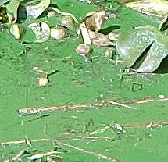MINIMIZING THE RISK
Emergency treatment for drinking water
- Filter the water
- Treat water with activated carbon
- Use chlorine as disinfectant (NB: Chlorine does not remove toxin)
NEVER ADD COPPER SULPHATE AND CHLORINE BEFORE FILTRATION AS
THIS WILL BREAK THE CELLS AND RELEASE THE TOXIN INTO THE WATER

|
FARMERS: PREVENT LIVESTOCK FROM HAVING ACCESS TO CYANOBACTERIAL SCUMS
WHAT MUST I DO IF I COME INTO CONTACT
WITH CYANOBACTERIA?
- Wash immediately with clean water
- If symptoms persist, consult your doctor
- Report the incident to the authorities in your region
(contact information)
First aid treatment
- Drink activated carbon charcoal tablets
- Treat symptomatically
WHAT IS IMPORTANT TO KNOW ABOUT CYANOBACTERIA?
- Blooms flourish in warmer summer waters and in many areas die down during winter
- Plant nutrients promote the growth of cyanobacteria
- Toxins produced can survive high temperatures
- Toxicity fluctuates constantly. It is possible for cyanobacteria to be toxic one day, and not the next
Find out more: HISTORY OF TOXIC CYANOBACTERIA IN SOUTH AFRICA...
Back to Toxic Cyanobacterial main page
Please send comments on these pages to
the webmaster
at the Resource Quality Information Services Directorate.
Last update
2015-08-13 11:57
|
